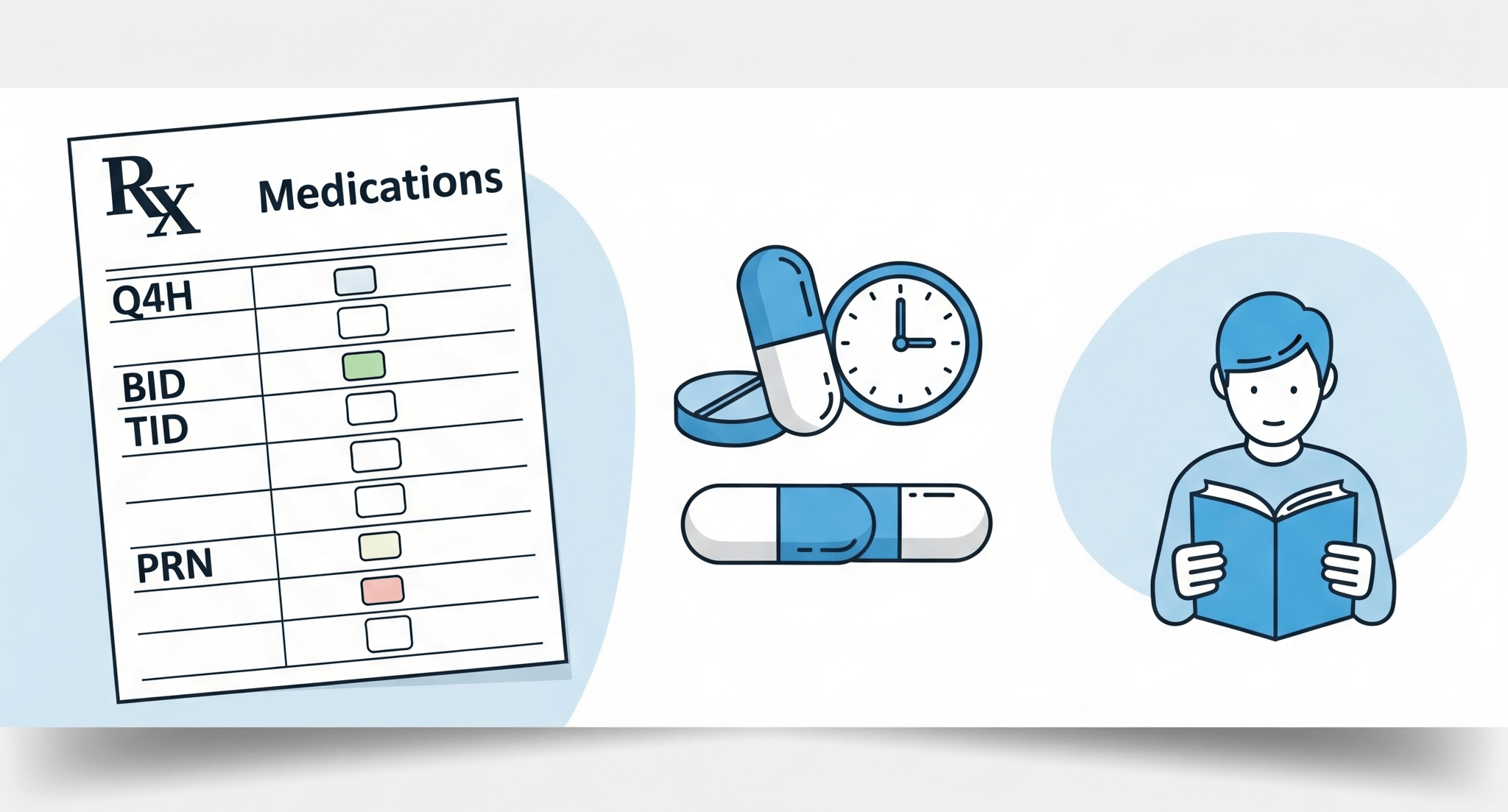Introduction
If you’ve ever read a prescription label or hospital chart and felt confused by the strange shorthand like “Q4H” or “BID,” you’re not alone. These medical abbreviations are commonly used by doctors, nurses, and pharmacists to save time and ensure consistency—but for patients and caregivers, they can be confusing or even risky if misunderstood.
In this article, we’ll demystify some of the most commonly used medical abbreviations, including Q4H, BID, TID, PRN, and others—so you can feel more informed, safer, and more in control of your healthcare.
What Does “Q4H” Mean?
Let’s start with one of the most frequently used abbreviations in hospitals: Q4H.
-
Q4H stands for “every 4 hours”
-
Comes from Latin: “quaque 4 hora”
-
It’s often used for medications that need to be administered at regular intervals to maintain consistent levels in the body
-
Example: “Take acetaminophen 500mg Q4H for pain” means take one dose every 4 hours
Understanding timing abbreviations like this is especially important for pain management, antibiotics, and post-surgery care.
Common Medical Abbreviations and Their Meanings
Here’s a handy list of essential abbreviations you might encounter on prescriptions, discharge summaries, or medication schedules:
|
Abbreviation |
Meaning |
Latin Origin |
Typical Use |
|---|---|---|---|
|
Q4H |
Every 4 hours |
Quaque 4 Hora |
Regular pain relief, antibiotics |
|
Q6H |
Every 6 hours |
Quaque 6 Hora |
Controlled medication timing |
|
BID |
Twice a day |
Bis in Die |
Morning and evening doses |
|
TID |
Three times a day |
Ter in Die |
Breakfast, lunch, and dinner times |
|
QID |
Four times a day |
Quarter in Die |
Regular dosing in short intervals |
|
QD |
Once daily |
Quaque Die |
Most daily meds (e.g., blood pressure pills) |
|
PRN |
As needed |
Pro Re Nata |
For pain, nausea, anxiety, etc. |
|
HS |
At bedtime |
Hora Somni |
Sleep aids or nighttime meds |
|
AC |
Before meals |
Ante Cibum |
Often used for insulin or digestive aids |
|
PC |
After meals |
Post Cibum |
Antacids, digestive enzymes |
|
PO |
By mouth (orally) |
Per Os |
Pill or liquid medication instructions |
|
IM |
Intramuscular |
— |
Injections (e.g., vaccines) |
|
IV |
Intravenous |
— |
Fluids or medication through a vein |
|
NPO |
Nothing by mouth |
Nil Per Os |
Pre-surgery or diagnostic procedures |
Why It Matters: Preventing Medical Errors
Misunderstanding abbreviations like Q4H or TID can lead to missed doses, overdose, or reduced treatment effectiveness. According to the Institute for Safe Medication Practices (ISMP), nearly 1 in 3 medication errors is related to dosing frequency or timing confusion.
Patients and caregivers who understand these abbreviations are better equipped to:
-
Follow medication schedules accurately
-
Ask the right questions during discharge or prescription reviews
-
Avoid dangerous self-medication errors
-
Advocate for loved ones in hospitals or long-term care settings
Examples You Might See in Real Life
Example 1:
Amoxicillin 500mg PO TID for 7 days
Means: Take by mouth, 500mg, three times a day, for 7 days.
Example 2:
Loratadine 10mg PO QD
Means: Take one tablet by mouth once daily.
Example 3:
Ibuprofen 400mg PO Q6H PRN for pain
Means: Take by mouth every 6 hours as needed for pain.
How to Keep Track
Managing multiple medications with abbreviations can be stressful. Here are a few tips:
-
Use a medication tracker app or print a simple chart with clear times and dosages
-
Ask your doctor or pharmacist to translate abbreviations into plain English
-
Label medications clearly at home, especially for seniors or children
-
For complex regimens, request a medication reconciliation sheet before hospital discharge
Abbreviations to Watch Out For
Some abbreviations have caused enough confusion that safety groups now recommend avoiding them altogether. For example:
-
QD (once daily) is often misread as QID (four times daily)
-
IU (international units) can be mistaken for IV (intravenous)
-
Trailing zeros (e.g., “5.0 mg”) can be misread as “50 mg” — it’s safer to write “5 mg”
When in doubt, always ask for clarification.
Empowering Patients Through Health Literacy
The healthcare system often assumes patients understand these medical terms, but that’s not always true. In fact, low health literacy is a significant factor in poor outcomes, especially for older adults, non-native English speakers, or caregivers with limited medical knowledge.
Learning these abbreviations is a small step that can lead to better outcomes, fewer errors, and more confident communication with healthcare providers.
Final Thoughts
Medical abbreviations like Q4H, BID, and PRN may seem intimidating at first, but they’re just shorthand for simple instructions. The more you understand, the more empowered you become as a patient, caregiver, or advocate.
Next time you see these codes on a prescription or hospital document, you’ll know exactly what they mean—and more importantly, how to follow them correctly.
Tip: Save this blog as a reference or share it with someone managing a complex treatment plan. Health literacy starts with small steps—and this is a powerful one.





